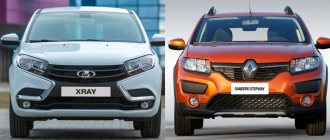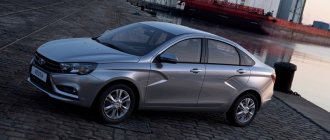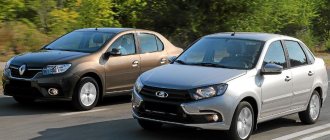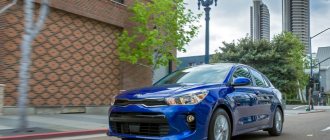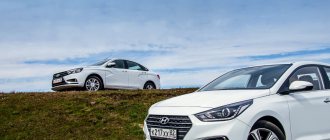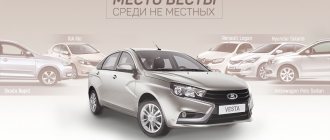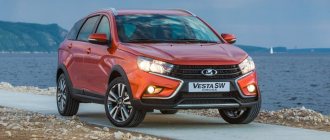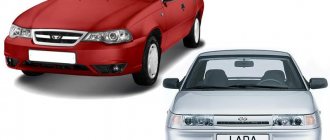They are spectacular, controversial and can compete with many front-wheel drive crossovers in cross-country ability. They are Lada Vesta Cross and Renault Logan Stepway. A couple that has no direct competitors in our market. Let's compare?
Oleg Kalaushin
Lada Vesta Cross 1.8 MT Price: 864,900 rub. On sale: from 2022
Renault Logan Stepway 1.6 MT Price: 792,990 rub. On sale: from 2022
These cars look extraordinary compared to their counterparts. Meanwhile, it was not AvtoVAZ or Renault who first came up with the idea of raising the sedan above the road surface and hanging it with plastic protection. For example, the Volvo S60 Cross Country recently showed off in such an unusual form on our market. True, because of the price it was not accessible to everyone, but it aroused genuine interest. And now it has become much easier to afford a non-trivial sedan. But is this style justified for a sedan, and which one should you choose? Moreover, the choice is small: there are only two.
Lada Vesta Cross and Renault Logan Stepway have quite a lot of configuration options. There is a choice of both engines and transmissions. But we decided to test cars with manual transmissions and in maximum trim levels. As a result, we tested Lada Vesta Cross 1.8 MT Luxe Prestige and Renault Logan Stepway 1.6 MT Drive. The price difference between these two models was almost 72,000 rubles, not in favor of Vesta Cross. However, if you add to this Logan configuration a rear view camera, an electrically heated windshield, the ERA-GLONASS system, as well as a security package with parking sensors, a stabilization and hold system when starting uphill, and thereby bring the set of options as close as possible to those of the Vesta Cross, there will be a gap the price will be less - about 33,000 rubles. But... let's figure out what Logan Stepway will not have and Vesta Cross will have, or vice versa, and how this will affect performance indicators.
Let's start with the appearance. We’ll probably omit what one car looks like compared to the other, but there is no doubt that off-road paraphernalia adorned both. Increased ground clearance and body kit, like a military uniform, suit almost everyone. By the way, the ground clearance is visually the same, but in figures Vesta Cross is higher above the ground: its ground clearance is 203 mm versus 195 for the Logan Stepway. But what can’t help but catch your eye about the Vesta Cross are its huge 17‑inch wheels, and they are eye-catching not only by the size of the wheels, but also by their design. Logan Stepway has smaller wheels, 16‑inches, plus the wheels, although they look like cast ones, are stamped with a characteristic pattern and caps. The Logan Stepway does not have alloy wheels as an option.
Also note that the Logan Stepway has LED daytime running lights, while the Vesta Cross has conventional incandescent lights. However, this option is more for those who are looking at you from the outside, because they light up only after starting the engine and are not visible to the driver, but it’s nice to know. If we’re already talking about starting the engine, then let’s also mention a system that allows you to do this remotely: Logan Stepway has it, but Vesta Cross does not. The function, I must say, is very useful. You can start the engine from a distance of about 100 meters, for example, from a house window. The engine runs for 10 minutes, warming itself up and warming up the interior. Or you can even schedule the engine to start every two hours, which is important in severe frost. At the same time, there is no need to worry that the car will be stolen: the engine immediately stalls if you open the door.
Vesta's exterior mirrors have a large area and visibility is excellent.
Logan's mirror is not as large as we would like.
Logan Stepway: Looks like a cast wheel, but is actually steel with a plastic hubcap.
While studying the exterior of the car, we also pay attention to how the gas tank flaps open. The Vesta Cross has a central locking mechanism, while the Logan Stepway has a separate handle on the threshold, next to the driver’s seat: both the location and the solution are strange. Vesta Cross has a more modern one. Since we have already opened the hatches, we note that the manufacturer recommends filling in Vesta Cross with 92nd gasoline, and in Logan Stepway either 95th or 98th. Naturally, the recommendation on the Vesta Cross hatch is initially more impressive. Although, if you get confused and recalculate the economic benefits of using cheaper fuel, but with slightly higher consumption, like Vesta Cross, it turns out that the cost of gasoline for the Logan Stepway will be approximately the same.
Vesta Cross rear passengers are provided with a USB socket and heated seats.
In the interiors, the originality of the Lada Vesta Cross and Renault Logan Stepway is emphasized only by minor touches - inscriptions on the backs of the front seats in the Logan Stepway and an aggressive color scheme in the Vesta Cross. Otherwise, these are the same familiar models with their advantages and disadvantages. For example, as noted earlier, the front seats of the Vesta Cross are more comfortable than those in the Logan Stepway. This is especially noticeable when you change from one car to another. What I like more about the Vesta Cross is the cruise control control - all the keys are on the steering wheel, while in the Logan Stepway the activation key is located on the center console, and the control buttons are on the steering wheel itself. Over time you can get used to it, but why is that so? It’s also nice that Vesta Cross has a rain and light sensor. The Logan Stepway doesn't even have wiper pause adjustment. And it’s completely incomprehensible why a car that has a remote engine start has no hooks for clothes on the second row. While the Vesta Cross provides not only this for rear passengers, but also heated seats. On the other hand, you wonder why the Lada, for almost 900,000 rubles, does not support Apple CarPlay and Android Auto, unlike the Logan Stepway. And the central display itself on Vesta Cross is very blurry. I just want to go into the settings to improve the contrast and brightness, but there is nowhere to improve it further.
The interior with bright inserts looks lively and surprisingly does not become boring.
The interior, compared to its competitor, is somewhat gloomy, but everything is sound and of high quality.
The information display on the instrument panel is also somewhat annoying in Vesta Cross, but not because there is little information on it. There is just enough of it if you look through the menu. Fine print complaints! To see something, you have to peer into it, and not grab it on the fly, just by touching it with your gaze. The disadvantages of the Logan Stepway speedometer include digitization in “odd tithes”. The gaze of the domestic car enthusiast is more accustomed to clinging to the numbers “60”, “80”, “100” than to “70”, “90”, “110”. And a series of small risks at the bottom of the main ones overloads perception.
Vesta "City Guide" standard navigation. Traffic information can be received via a connected smartphone.
The standard Logan multimedia supports Apple CarPlay and Android Auto.
This winter is perhaps the best confirmation that the higher the vehicle's ground clearance, the greater the driver's chances of getting to the right place and finding a parking space. By and large, both on Vesta Cross and on Logan Stepway you can hang a sticker “I don’t care about the snow, I park where I want.” Of course, this is somewhat exaggerated, but in reality, finding a place “under the office”, with such impressive ground clearance, is much easier than in a regular passenger car. And it would be even easier if the cars were shod with tougher rubber, and not with city Velcro. So we advise future owners: for the winter, in order to fully experience all the delights of the cross-country ability of these cars, only studs with a meaner tread. In the absence of one, on a frankly slippery surface, in most cases both cars had to start from second gear. And although the traction control systems tried to speed up the launch by preventing the tires from turning in first gear, it was easier to do this in second. At the same time, the gears themselves in Lada and Renault are engaged equally easily and clearly.
For a tall passenger in the Vesta Cross, the ceiling “presses” slightly.
The Logan Stepway has more headroom in the second row.
As for the behavior of cars on clean asphalt, Vesta Cross is preferable in terms of handling, stability and noise insulation. But if you suddenly encounter any unevenness, then on the Logan Stepway you will notice them when they have already reached open holes and gouges, but on the Vesta Cross you will have to reduce the speed earlier: even when standing on tiptoes, it is more sensitive to unevenness. The dynamics of the cars are almost identical, and the difference of tenths of a second when accelerating to hundreds can be neglected, attributing them to the driver’s agility or natural factors - wind or air temperature. Is that the maximum speed of Vesta Cross is higher.
The instrument panel for Cross is made in the original color scheme.
A huge number of risks, both on the speedometer and on the tachometer, are somewhat annoying. But large numbers on the trip computer are easy to read.
So who is better? In terms of general consumer properties, Vesta Cross prevails. It has more available options, handles better, and looks more impressive. But if we remember the amazing reliability of Renault Logan of previous generations and the fact that the current Logan Stepway is actually the same car, only with increased ground clearance, then it is also wrong to discount it. And it is only slightly inferior to Vesta Cross, in fact by as much as it is cheaper.
Lada Vesta Cross
| Driving Good on the highway and quite capable of plowing the country roads. The dynamics are at the level of the competitor, but the steering is better.
Salon It looks quite modern, spacious, but there are some complaints about the assembly.
Comfort Noise insulation is good, and the suspension is more designed for good roads. Comfortable seats front and rear.
Safety At the level of sedans in its class.
Price Justifiably more expensive than a similar sedan.
Average score 7,8 |
Renault Logan Stepway
| Driving Doesn't handle as sharply as its competitor. Rolls a little more. The dynamics are acceptable.
Salon Well assembled, spacious, the overall impression is spoiled only by the not very comfortable front seats.e.
Comfort The energy-intensive suspension allows you not to think about the condition of the road surface, but the sound insulation is not very good.
Safety Meets competitor's security level.
Price A little more expensive than a regular Logan.
Average score 7,8 |
The trunk of the Lada Vesta Cross is 480 liters, which is a good result for a car of this class.
However, the trunk of the Renault Logan Stepway is 510 liters. The volume is more than sufficient.
Comparing the design of Renault Logan and Lada Vesta
Comparing the design of these two cars is not so easy.
But we will find something to cling to. Lada Vesta literally breaks the mold with its design, its shapes and X-style. This is definitely a fresh breath of air in automotive design. And you know, the car was to the liking of many buyers. Just look at these shapes, these headlights. Everything looks as balanced and appropriate on this car as possible. Logan, although he looks more restrained, is authentic in his own way. The design displays a distinctive style and notes of calm. Smooth and elegant lines can be seen literally in everything. This is not to say that the car looks too fresh, but its design cannot be called outdated either. I would say that this car is aimed specifically at an adult audience and this is where it is very difficult to compete with it.
And to be honest, I would give Vesta a 5 for design, and Logan a solid 4.
Chassis behavior
Let's move on to driving performance. Interior noise insulation is at a quite decent level. For a car in the budget price category, the noise levels in the cabin are quite good. But it would be better to replace the front strut boots. They are made of dense plastic, so when the suspension operates they create additional noise.
The suspension itself is adjusted very well. The designers managed to find the optimal balance between smoothness and rigidity. Therefore, the suspension handles unevenness well and provides decent comfort.
The designers also did a good job on the steering. Optimal operation of the electric booster gives the car good handling.
As for the braking system, its disadvantage can be considered the use of drum mechanisms on the rear axle. They still read somewhat outdated. And there is a high probability of the pads sticking in winter when using the handbrake. This drawback on the West station wagons, which are preparing for release, has been eliminated and disc brakes have been installed at the rear.
↑ Lada Vesta: advantages and disadvantages
The technical characteristics of the car immediately surprised potential buyers. Vesta is truly a new generation of Lada, bursting into the present.
Taking a close look at the car, you notice some advantages over other foreign models.
↑ Engine
The Russian sedan is equipped with three types of power units and two gearboxes. All engines with a volume of v1.6 and v1.8 liters with 8 and 16 valves with a power of 87 and 106 horses. They operate stably and do not require intervention over a long period of operation. These two engines are developed and produced by AvtoVAZ.
Another 118 hp engine. With. - Japanese Nissan. This option has a higher cost, but has higher performance and fuel consumption, similar to the two previous Russian models. Compared to imported cars in the same category, Lada Vesta has more advantages, because foreign analogues are equipped with 2 types of engines.
↑ Patency
The domestic model has high ground clearance (the height is 171 centimeters when fully loaded), which allows you to easily overcome high curbs, speed bumps, move freely over rough terrain and get out of shallow holes. The car behaves very well on slippery roads. All this attracts Russian buyers, given the condition of our roads.
The smooth ride of the car ensures that the front suspension is stiff and the rear suspension is soft, which also provides significant benefits for the driver to feel the road while driving.
↑ Convenience
The Vesta sedan, in terms of its interior dimensions, belongs to class B. The configuration and ergonomics of the car allow drivers and passengers of average and above-average height to sit comfortably in the cabin. Lada car seats have been improved, starting with the basic “Classic” configuration. The rear seat is equipped with three head restraints.
Air conditioning in the basic series, a good audio system, and heated front seats in the middle version leave its competitors, including the French sedan Renault Logan, far behind.
Currently reading: Renault Logan gearbox: device and switching diagram
↑ Security
All variations of Vesta are equipped with ABS and ESC, as well as systems that limit the speed of the vehicle in case of a dangerous roll and send a message to the rescue service if the car gets into an accident.
Along with the advantages, of course, there are also some disadvantages:
- The design of the suspension with greater engine performance can affect the car's uncertainty when taking sharp turns at high speeds.
- The steering column is inconvenient to adjust by the driver.
- The driver's door armrest just gets in the way for some people.
Important. Lada Vesta in its most basic configuration differs in many ways from the foreign Logan in a positive way. The most important thing is the acceptable cost of the car and further minor maintenance costs.
↑ Technical characteristics
To compare Lada Vesta and Renault Logan, in addition to external data, it is necessary to take into account the driving performance of vehicles in our climate and the condition of the roads. In this regard, Lada takes over. The difference in ground clearance is noticeably felt when the cars are fully loaded, taking into account all the bumps on the road. The suspension design is better improved than that of Logan.
↑ Engines
Vesta is definitely ahead in the number of engine types and horsepower they produce. Lada is represented by 3 engines, while Logan has only 2, one of which is an 8-valve 1.6-liter engine. With multipoint injection, the unit is capable of producing only 82 l/s, which is not as much as we would like. Full power is achieved only when reaching 5 thousand rpm, and maximum thrust does not begin to develop immediately, but when reaching 2.8 thousand rpm. The second is a more powerful naturally aspirated 102 l/s 16-valve unit.
Starting with a 1.6 liter engine, the Lada Vesta has no chance of becoming a leader. All parameters: fuel consumption, power, dynamics are within the same limits as those of Logan. But the new 1.8 liter unit is capable of developing power up to 122 horsepower, which significantly improves Vesta’s position. In terms of efficiency, Renault is more profitable than the domestic model, but not so significantly.
↑ Gearboxes
A comparative analysis of the AvtoVAZ model and the French Renault showed that the gearbox on Vesta is no different from its competitor. Both are equipped with five-speed manual transmissions and robotic automatic transmission units. Vesta’s manual transmission is much easier to shift. In Logan, the gear shift knob often vibrates when the car is moving.
The presented Vesta box received a lot of positive feedback from car enthusiasts. According to information, AvtoVAZ plans to begin producing CVTs for its model in the near future.
↑ Chassis
The updated Logan 2 handles Russian roads better. The rear pillars have been strengthened, the car has become smoother to move. The Lada initially has a hard suspension in the front and a soft rear, which promotes smooth movement and prevents the car from shaking on uneven roads.
The advantage in ground clearance gives Vesta more room to maneuver on rough roads with many potholes and uneven spots. A clear advantage of the domestic model is that it was originally developed to suit our conditions, and was not adapted during operation. Therefore, the Frenchman is inferior, having acquired only reinforced springs and a stabilizer, which means that he does not have the cross-country ability and reliability that the Lada has.
↑ Interior
In this category our car wins again. The interior of the car is richer and more impressive than that of its rival.
- Space. Well-placed front and rear seats provide more space inside the cabin for passengers. Lada is inferior in height to Logan.
- Comfort. It is more comfortable to sit in Vesta; the front car seats are well adjusted.
- Trunk. In terms of squad size, the Frenchman is significantly ahead of the enemy.
- Technical equipment. All instruments are clearly readable by all competitors, and multimedia sound is clear.
↑ Options and cost
Lada Vesta has 6 trim levels, while Renault Logan has only 4. Some variations among these brothers may seem exactly the same. At the initial level, the cost of Logan is lower than that of Vesta, but with a set of options the price increases and becomes higher. We find that the price range for Logan is greater (from 470 to 720 thousand rubles) than for Vesta (from 515 to 630 thousand rubles).
Advice. Comparing the two cars, we can firmly say that buying our Lada is more profitable. It has several engine options, which allows you to adjust the power and fuel consumption. Vesta is more suitable for Russian roads and can withstand loads longer. The Lada is equipped with packages of additional options and the car’s equipment is thought out to the smallest detail.
So which is better, Lada Vesta or Renault Logan? If we compare these cars in the same price category, then Vesta is much more pleasant to drive, safer, more powerful and better equipped. Of course, these two cars are widely popular and are sales leaders in our country. They rightfully take their place among the models in their class. Which one to choose is a matter of taste for the buyer.
Chassis - who has it better? Logan or Vesta?
Suspension of Renault Logan 2 - on top, Lada Vesta - below.
And again, it’s difficult to compare here - Logan and Vesta have almost the same suspension design. Simple MacPherson strut at the front and torsion beam at the rear. But there are significant differences in the suspension setup itself. In this regard, I would like to immediately praise AvtoVAZ - the suspension of the Lada Vesta turned out to be very stiff and energy-intensive, which had a positive effect on handling and driving on uneven roads. Even the high ground clearance did not worsen the car's handling. Although many bloggers said that the car’s suspension was a bit harsh. Personally, I don't think so.
Logan lacks chassis tuning. In general, it drives well, absorbs bumps well, but does not have the desired steering clarity. But the second Logan did not lose its legendary indestructibility of the suspension. Remember why taxi drivers fell in love with these cars?
And here we have a reasonable question. Who to give preference to? Indestructibility or excellent taxiing? Let's give both cars a draw.
Dimensions
A comparison of Renault Logan and Lada Vesta cars should be made in terms of dimensions. First, let's take a look at the dimensions of the domestic representative:
- length 4410 mm;
- width 1764 mm;
- height 1497 mm;
- ground clearance 178 mm;
- trunk volume 480 l;
- vehicle weight 1230 kg.
"Lada Vesta Cross". Photo source: https://versiya.info/avto/116533/amp
Now let's look at the French Renault Logan:
- length 4346 mm;
- width 1733 mm;
- height 1517 mm;
- ground clearance 155 mm;
- trunk volume 510 l;
- weight 1106 kg;
- The wheelbase of both cars is almost identical, the difference is 1 mm (2635 mm Vesta and 2634 mm Logan).
Renault gets a “winning point” only in terms of trunk volume and for a slight advantage in body height, while in other respects it is inferior to Lada.
What to buy – Lada Vesta or Renault Logan?
This car was developed specifically for a wide range of people who want to buy a car. Most buyers want to see in a car, first of all, reliability, practicality and efficiency. The latest version of Renault Logan has all these parameters. Some advantages of the model are noted:
- ground clearance allows the car to easily overcome small obstacles: uneven roads, small curbs and holes;
- Logan's bottom is reinforced and protects brake lines well;
- reinforced suspension;
- an 8-valve engine can run on lower quality fuel;
- the car is maneuverable and has good maneuverability;
- simplicity of design, thanks to which the machine can easily be repaired independently;
- spare parts are easy to find;
- excellent optics;
- good cruise and climate control;
- high seating;
- adapted to the Russian climate and is not afraid of frost, the cabin is not cold in winter.
The disadvantages of a French car are:
- airbags in a single quantity;
- no force limiters;
- seat belts without pretensioners;
- accelerates slowly, and the first 4 gears of the box are short;
- weak audio system;
- The car has a problem with reverse gear - it doesn’t turn on well;
- sound insulation leaves much to be desired, especially at an increased speed of 100 km/h;
- arches in the trunk interfere with the convenient location of the cargo;
- the stove operation is noisy after the 4th division;
- The front mudguards are too narrow and dirt gets onto the car doors in bad weather.
Above the curb
But it was not for the sake of nameplates on the body and inscriptions in the interior that all these crossover games were started. The key to elevated sedans is their ground clearance numbers and obstacle-clearing ability.
Here, both cars are fine, although their ground clearance is different. “According to the passport,” the lowest point of the Vesta body moved away from the ground by 203 mm, the Renault’s ground clearance is 195 mm. If we talk about the distance under the bumpers, which is more important in the city, then the competitors are almost equal.
But on the Stepway you can park backwards near any curb: in this case there is 370 mm of reserve under the bumper versus 330 mm for the Cross. By the way, the height of Stepway differs quite significantly from just Logan - according to the manufacturer’s data, the difference is as much as 40 mm! The clearance of the Cross version is only 25 mm greater than that of the Vesta sedan.
The ground clearance of both cars is impressive, so on snowy roads they feel better than their “down-to-earth” competitors. Front-wheel drive is not a hindrance - this couple slips through snow debris at speed, without even touching the bottom. The main thing is not to brake and remember how easily a front-wheel drive car “buries” in the snow.
Both test cars have Velcro, but for frequent trips on country roads, studded tires are more suitable - it will be easier to get out on them if the ground clearance alone is still not enough.
Renault Logan 2 or Lada Vesta: battle of salons
If with engines and gearboxes you can definitely say where the favorite is, then in terms of the interiors of both cars, almost everything is the same. The finishing materials are similar, the plastic is equally hard everywhere. However, Vesta’s interior looks more solid and newer. Not to say that this is business class, but everything is very harmonious and thought out. I would even say that it is more expensive.
Currently reading: Clutch adjustment on Renault Logan with 1.4 and 1.6 engines
They also worked on the design of Logan's interior. If you compare it with the previous generation, you can immediately feel progress. The design has become more thoughtful, but there are a number of comments - the air duct nozzles do not fit very harmoniously, and the door trims are not well thought out. Otherwise, all the elements are in place.
As for seating, the Vesta is much more comfortable in the front, and there is much more space in the back. Otherwise, there are no comments to either one or the other interior.
Gearboxes
In general, the situation is equal - both Vesta and Logan have 5-speed manual gearboxes, as well as 5-band robotic units of the AMT type. Vesta’s “mechanics” are better - it works more clearly, and the lever moves are not as loose as in Logan. In addition, sometimes the Frenchman's manual transmission lever vibrates.
The AMT in both cars copes with its responsibilities - it switches gears quite quickly, making driving more comfortable and easier. Of course, there are jerks and spots, but within normal limits.
The advantage of Renault Logan is its 4-speed automatic transmission. The classic automatic transmission works noticeably softer than robots, which affects comfort. However, the car’s budget did not allow installing a 5-speed transmission on Renault, and with the existing one, the sedan noticeably loses to the AMT on the highway.
↑ Prestige and body
To determine what superiority the Lada Vesta has among cars that represent the B class, you can compare it with the French Logan 2. It is the one that is more suitable in terms of technical characteristics and price. Renault Fluence or Captur models, the cost of which is much higher, are not taken into account.
Let's compare the second Logan and Vesta in terms of car prestige. Our Lada definitely has the advantage. The modern Lada model is unrecognizably different from previous AvtoVAZ representatives. The design and technical parameters of Vesta play a significant role in trying to compete for a prize among foreign cars.
Of course, the second Logan is far ahead of the first version in terms of external design. The restyling turned out to be excellent: new headlights, grille, quality material on the front and rear seats. After its release, Logan 2 received a huge number of reviews, both positive and negative. But still I liked the model.
The Lada Vesta produced an even greater effect. After her first presentation, reviews poured in on the Internet. The car made a strong impression on car enthusiasts. The body has undergone changes; it has greater length, width and ground clearance than its competitor. The only thing is that Logan’s trunk volume is 30 liters more.
Appearance of rivals
Vesta's exterior style most likely overshadows Renault's appearance. Lada is made in high-tech style. This trend is visible from all sides. The front end sets the rhythm, primarily due to the narrow rectangular headlights and the radiator grille, which forms the letter X in tandem with the air intake. These elements are finished in chrome, which gives more modern style.
Turning our gaze to the profile, we see the appearance of unique stamped body parts, which are located in the area of the front and rear fenders and slightly fill the doors. In combination, the front and rear stampings also form an X. The rear part of Vesta is distinguished by stylish ergonomic headlights. New development: the use of large 4 letters LADA as a nameplate. All these features combined with stylish wheels create a bright, memorable design.
Logan cannot fully answer the Lada in this aspect, despite the fact that after restyling the French car acquired an updated, fresh exterior. The front of the “Frenchman” has been transformed, acquiring massive rounded shapes, but the side has retained restraint and modesty, which immediately declares the car’s budget. Recesses for the door handles also cheapen the Logan's appearance a bit. The trunk is original and nice, and significant improvements are also noticeable.
Logan's exterior clearly does not match the appearance of the Lada Vesta.
Options and prices
Currently, Lada Vesta is sold in 4 different trim levels at prices ranging from 554,900 rubles to 809,400 rubles. Also, additional option packages are offered for the basic configurations - Start, Image, Mulimedia and Prestige.
Logan will be much simpler in terms of trim levels and options - 4 trim levels: Access, Life, Drive, Style at prices ranging from 554,000 to 812,990 rubles.
If you compare the basic versions, Logan is only 900 rubles cheaper, but for this money you will get a very poor equipment of the car, and even with an 8-valve engine. Such configurations are usually purchased by people with a very limited budget or by organizations for company cars - taxis, delivery services, private security companies, etc. Vesta, for the money, will be noticeably better equipped.
Vesta fully equipped will cost the buyer 809,400 rubles, and Renault Logan - 812,990 rubles. Here Logan turns out to be a little more expensive, but not significantly - only 3590 rubles. On the scale of buying a car, this is a very insignificant amount.
1.6 l 16-cl. (106 hp), 5MT / Classic - 554,900 rubles 1.6 l 16-cl. (106 hp), 5MT / Classic / Start - 579,900 rubles 1.6 l 16-cl. (106 hp), 5AMT / Classic / Start - 604,900 rubles 1.6 l 16-cl. (106 hp), 5MT / Comfort - 607,900 rubles 1.6 l 16-cl. (106 hp), 5MT / Comfort / Image - 630,900 rubles 1.6 l 16-cl. (106 hp
Currently reading: Which car to choose: Lada-Largus or Renault-Logan
), 5AMT / Comfort - 632,900 rubles 1.6 l 16-cl. (106 hp), 5MT / Comfort / Multimedia - 635,900 rubles 1.8 l 16-cl. (122 hp), 5MT / Comfort - 642,900 rubles 1.6 l 16-cl. (106 hp), 5AMT / Comfort / Multimedia - 660,900 rubles 1.8 l 16-cl. (122 hp), 5MT / Comfort / Image - 665,900 rubles 1.6 l 16-cl. (106 hp), 5MT / Luxe - 670,900 rubles 1.8 l 16-cl. (122 hp
), 5AMT / Comfort / Image - 690,900 rubles 1.6 l 16-cl. (106 hp), 5MT / Luxe / Multimedia - 698,900 rubles 1.8 l 16-cl. (122 hp), 5MT / Luxe - 705,900 rubles 1.6 l 16-cl. (106 hp), 5MT / Luxe / Prestige - 716,900 rubles 1.6 l 16-cl. (106 hp), 5AMT / Luxe / Multimedia - 723,900 rubles 1.8 l 16-cl. (122 hp), 5MT / Luxe / Multimedia - 733,900 rubles 1.8 l 16-cl. (122 hp
Access 1.6 l, 82 hp, MKP5 — 554,000 rub. Life 1.6 l, 82 hp, MKP5 — 617,990 RUB. Life 1.6 l, 113 hp, MKP5 — RUB 677,990 Life 1.6 l, 102 hp, automatic transmission 4 — RUB 707,990 Drive 1.6 l, 82 hp, MKP5 — RUB 692,990 Drive 1.6 l, 113 hp ., MKP5 — RUB 732,990 Drive 1.6 l, 102 hp, AKP4 — RUB 762,990 Style 1.6 l, 82 hp, MKP5 — RUB 742,990 Style 1.6 l, 113 hp, MKP5 - RUB 782,990.Style 1.6 l, 102 hp, AKP4 - RUB 812,990.
What do they offer for our money?
Quite a reasonable price for a new car. For this money the buyer receives:
- fog lights;
- power windows for rear doors;
- heated windshield;
- light and rain sensors;
- armrest for the driver's seat;
- wheels (16-inch).
The engine is from today's usual economical series: volume 1.6 liters, power 106 hp. With.
If you wish, you can pay an additional 25 thousand rubles and get a robotic gearbox - a cross between an “automatic” and a manual gearbox, which is popular today (in fact, a manual gearbox that is controlled electronically and not directly by the driver).
You can also invest some money and expand the “luxury” offered by getting the XV Line kit, which includes such wonderful gadgets as a spoiler, exhaust tip, pedal covers, cruise control, rear view camera, touch screen and navigation. This option will cost 663 thousand rubles.
What's the end result? What to choose Lada Vesta or new Renault Logan?
Both cars presented in the review, Renault Logan and LADA Vesta, are undisputed leaders in their segment and are truly extremely popular among buyers in the Russian Federation. At the same time, the domestic model became the winner in many respects, but it’s up to you to decide what to choose.
If you put aside emotions, then only facts will remain that will help you determine which is better - Lada Vesta or Renault Logan 2. If we take equal prices, then Vesta will turn out to be more profitable - richer equipment, better control, more safety and even more powerful. If you take the TOP, it will also be cheaper. But Logan can also be upgraded to Vesta’s level, but this is an additional investment that will further increase the price gap.
Let's try to identify the leader
Lada Vesta, as well as Renault Logan, which has been represented on the domestic automobile market for about 10 years, have many advantages over many other modern cars, which puts them an order of magnitude higher in our market segment. The Lada model immediately became popular, and its sales are incredible, but the Renault model is also consistently the best-selling foreign car in our country. Opinions differ here, which is better? It's worth continuing the comparison.
So, Lada Vesta is larger in overall dimensions than its competitor, and has 100mm more in all parameters. This makes the car belong to class B+, but Renault Logan does not have a plus sign. This allowed Vesta to get a large luggage compartment and a spacious interior. And the car itself, which is equipped with sports overhangs, despite the fact that its dimensions are impressive, looks respectable.
If we compare cars from the point of view of the interior and its design, then the representative of France becomes the undisputed leader. Although the first generation car is more suitable as a family car, which is reflected in the interior design.
Officially, Renault Logan engineers position it as a budget model, so inexpensive materials were used in the finishing. What speaks most about a car is its comfort and driving dynamics. This is evidenced by the power of the power plants of the Lada Vesta and its competitor. Lada presented its car with a series of power plants, of which there are 4 types, with a capacity of 87 l/s, 102 l/s, 114 l/s and 128 l/s. The Logan sedan is equipped with only 2 units, with a capacity of 82 l/s and 102 l/s. Because of this, the comparison is in favor of the Russian model.
If we talk about objectivity, then West should have been compared with the latest version of Logan. The power units remained unchanged, but a nice, modern, new design appeared. More expensive materials were used in the decoration. And most importantly, for the powerful 102 l/hp engine, a variator was introduced.
If you pay attention to the exterior of the Lada Vesta and Renault Logan, then it is indeed extremely difficult to decide which is better and which to choose for yourself. Both models are clear examples of the latest European design trends, and in their configurations they have the latest technologies and options, and this can now be offered to customers
The Frenchman is still let down by the materials used for finishing. Despite the rather beautiful plastic, it is very hard and not very pleasant to the touch.
If we compare the dimensions, the Renault Logan has a small but advantage over the LADA Vesta model. The domestic model, as before, is larger in size relative to Logan. This sedan from France does not boast a spacious interior and a spacious luggage compartment, but this makes the maneuverability of the car much better, and it is also much easier to park in such a car, which has been very important lately.
The driving characteristics of the Renault sedan have become better than those of the 1st generation, however, the model does not lag behind the Lada, and offers buyers modern engines and transmissions. In total, only 2 power plants are offered for foreign cars, while Russian cars have 5 of them. In addition, Russian engines are more dynamic and responsive, which makes domestic developments the leaders.
↑ interior
In this category our car wins again. The interior of the car is richer and more impressive than that of its rival.
- Space. Well-placed front and rear seats provide more space inside the cabin for passengers. Lada is inferior in height to Logan.
- Comfort. It is more comfortable to sit in Vesta; the front car seats are well adjusted.
- Trunk. In terms of squad size, the Frenchman is significantly ahead of the enemy.
- Technical equipment. All instruments are clearly readable by all competitors, and multimedia sound is clear.
Passport details
| Model | Lada Vesta Cross 1.8 AMT | Renault Logan Stepway 1.6 CVT |
| Body | ||
| Body type | sedan | sedan |
| Number of doors/seats | 4/5 | 4/5 |
| Length, mm | 4424 | 4368 |
| Width, mm | 1785 | 1761 |
| Height, mm | 1526 | 1571 |
| Wheelbase, mm | 2635 | 2634 |
| Front/rear track, mm | 1524/1524 | 1486/1482 |
| Curb weight, kg | 1230–1380 | 1154 |
| Total weight, kg | 1670 | 1611 |
| Trunk volume, l | 480 | 510 |
| Engine | ||
| Type | petrol | petrol |
| Location | front, transverse | front, transverse |
| Number and arrangement of cylinders | 4, in a row | 4, in a row |
| Number of valves | 16 | 16 |
| Working volume, cm³ | 1774 | 1598 |
| Max. power, hp/rpm | 122/5900 | 113/5500 |
| Max. torque, N•m/rpm | 170/3700 | 152/4000 |
| Transmission | ||
| Transmission | robotic, five-speed | variable speed drive |
| Drive unit | front | front |
| Chassis | ||
| Front suspension | independent, spring, McPherson | independent, spring, McPherson |
| Rear suspension | semi-independent, spring | semi-independent, spring |
| Front brakes | ventilated disc | ventilated disc |
| Rear brakes | disk | drums |
| Tires | 205/50 R17 | 205/55 R16 |
| Ground clearance, mm | 203 | 178 |
| Performance characteristics | ||
| Maximum speed, km/h | 180 | 170 |
| Acceleration time from 0 to 100 km/h, s | 12,7 | 12,1 |
| Fuel consumption, l/100 km | ||
| — urban cycle | 9,6 | 8,6 |
| - suburban cycle | 6,2 | 5,6 |
| - mixed cycle | 7,5 | 6,7 |
| Toxicity standard | Euro 5 | Euro 5 |
| Fuel tank capacity, l | 55 | 50 |
| Fuel | AI-92 | AI-95 |
New Lada: Disadvantages of Lada Vesta: objective opinion after 500 tests and 5000 kilometers
Behind the wheel
Suspension
- The regular Vesta SW station wagon has a rear suspension exactly like a sedan, but the characteristics of the springs and shock absorbers have been slightly revised for higher loads.
- Cross has different springs: thanks to them, the ground clearance is increased from 178 to 203 mm.
- This is the first production Lada with suspension like Subaru!
- There was not even a hint of a breakdown on any of the asphalt waves and holes that abound on the narrow mountain road to Solohaul (a famous rally stop!).
Engine and transmission
- The combination of a 122-horsepower engine and a manual transmission is fire! There is always enough engine, although there are three passengers in the car besides me and some luggage.
- The clutch does not require filigree footwork: you just release the pedal and go.
- Only occasionally did a slight itch irritate me, but this, as the engineers assured me, was a consequence of the fact that the engine calibration had not yet been completed.
Control
- The strength of the Cross is also that it handles perfectly - better than a sedan.
- ESC is triggered later than on a sedan, allowing you to drive a little more actively and slide longer without the intervention of an electronic guard (due to the fact that ESC is triggered, among other things, by the steering angle sensor + low-profile tires).
- Low-profile tires, with a stiffer sidewall, so when turning the steering wheel you deflect at smaller angles - the car changes course more readily and turns more actively into turns than on higher and softer tires.
- Active drivers will like it - you can afford a little more than usual. Living machine!
Brakes
For ESP operation, disc brakes are preferable: they are faster, especially on rough roads.
Body
The torsional rigidity of the body (on an empty car) is sufficient. The rear right wheel is a couple of millimeters off the ground, but all the doors, including the trunk, open easily.
Link to test drive.
Cost of ownership
After purchasing a new car, the question of maintenance and its cost inevitably arises. Let's answer it in advance. To do this, let’s compare prices for routine maintenance at official dealers of automakers in Moscow up to 60,000 km (inclusive). Lada Vesta 2022: TO-1 (15,000 km) - 6,600 rub.
, TO-2 (30,000 km) - 8,800 rubles, TO-3 (45,000 km) - 6,600 rubles. and TO-4 (60,000 km) - 8,800 rub. Total: 30,800 rubles. Renault Logan 2022: TO-1 (15,000 km) - 9,048 rubles, TO-2 (30,000 km) - 9,048 rubles, TO-3 (45,000 km) - 9,048 rubles. and TO-4 (60,000 km) - 10,461 rubles. Total: 37,605 rubles, that is, 6,800 rubles. (22%) more expensive.
And in conclusion, let's compare the cost of CASCO. To do this, we will use existing online calculators. And as initial data we will use cars worth 700,000 rubles, which will be driven in Moscow by a married 50-year-old woman with two children and 25 years of driving experience. As a result, the price for Lada Vesta 2022 vs Renault Logan 2022, depending on the insurance company and type of policy, is as follows:
- Renaissance Insurance “Necessary protection” - 13,893 rub. vs RUB 25,412;
- Zetta Insurance “Not at fault” - 15,400 rub. vs RUB 25,900;
- Liberty Insurance "CASCO Direct" - 28,890 rub. vs RUR 43,160;
- MAX “Standard” - 52,000 rub. vs 74,100 rub. respectively.
That is, voluntary insurance of a French sedan against the risks of theft and damage will cost on average 60% more.
Summary
Lada Vesta 2022 model year looks very attractive from a financial point of view. This applies to both the cost of the model itself and the costs associated with vehicle maintenance and insurance. For those who like fast driving, Lada can offer a more powerful engine, and for those who want to stop at gas stations less often, economical modifications with a robotic gearbox and a gas tank that is 5 liters larger than that of its opponent.
Renault Logan 2022 may interest buyers with its low starting price, top-end equipment, the dynamics of the version with automatic transmission and a large trunk. But upon closer examination, it turns out that the basic Renault equipment options are too ascetic, and few people in the budget segment are interested in the maximum configurations.
